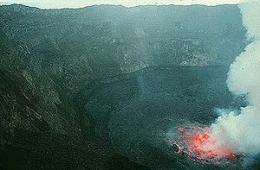Fledgling mantle plume may be cause of African volcano's unique lava

(PhysOrg.com) -- Nyiragongo, an active African volcano, possesses lava unlike any other in the world, which may point toward its source being a new mantle plume says a University of Rochester geochemist. The lava composition indicates that a mantle plume—an upwelling of intense heat from near the core of the Earth—may be bubbling to life beneath the soil of the Democratic Republic of the Congo. The findings are presented in the current issue of the journal Chemical Geology.
"This is the most fluid lava anyone has seen in the world," says Asish Basu, professor of earth science at the University of Rochester. "It's unlike anything coming out of any other volcano. We believe we're seeing the beginning of a plume that is pushing up the entire area and contributing to volcanism and earthquakes."
Basu analyzed the lava, which resides in the world's largest lava lake—more than 600 feet wide inside the summit of Nyiragongo—and found that the isotopic compositions of neodymium and strontium are identical to ancient asteroids. This suggests, says Basu, that the lava is coming from a place deep inside the Earth where the source of molten rock is in its pristine condition.
Because the Earth's crust is undergoing constant change via tectonic motion, weathering, and resurfacing, its chemical composition has been dramatically altered over its 4-billion-year lifespan, but the Nyiragongo magma source in the deep mantle has not, says Basu. That magma source is thought to retain some of the solar system's original make-up of elements, and this is what Basu and his colleagues believe they have detected in Nyiragongo's lava lake.
Scientists believe mantle plumes can last hundreds of millions of years, and that their heat can create phenomena such as Yellowstone National Park or the string of Hawaiian Islands. Basu says Nyiragongo's frequent eruptions may be the birthing pains of a similar plume and the possible beginning of new large-scale geological formations in the region.
Basu says other well known features of the region also point toward the idea of a growing plume. Nyiragongo lies on a vast ring of volcanoes and fissures that wrap around Uganda and the United Republic of Tanzania, and inside this ring the land is domed upward more than a mile above sea level. Basu believes the head of the plume is pooling in this region, pushing it upward like a 500-mile-wide air bubble in a pie crust.
But it is Nyiragongo, says Basu, that is being fed directly from the plume. Another volcano, Nyamuragira, just 15 miles to the north of Nyiragongo displays much more conventional lava compositions. Basu says this is because Nyamuragira is being fed from the edge of where the plume's head is pooling, mixing in elements of melted crust and upper mantle, whereas Nyiragongo is being fed directly from the plume's main body. Together the two mountains are responsible for approximately 40 percent of all of Africa's volcanic eruptions.
"This is a very troubled region of the world, and we hope to be able to help better understand the conditions under which the people of that area must live," says Basu. Nyiragongo last erupted in 2002, sending its super-fluid lava down its slopes at more than 60 miles per hour toward the nearby town of Goma, destroying 4,500 buildings and leaving 120,000 homeless. Basu and other scientists hope that understanding the composition of the lava that feeds Nyiragongo may help ongoing worldwide scientific efforts to understand the hazards of the region.
Source: University of Rochester (news : web)

















